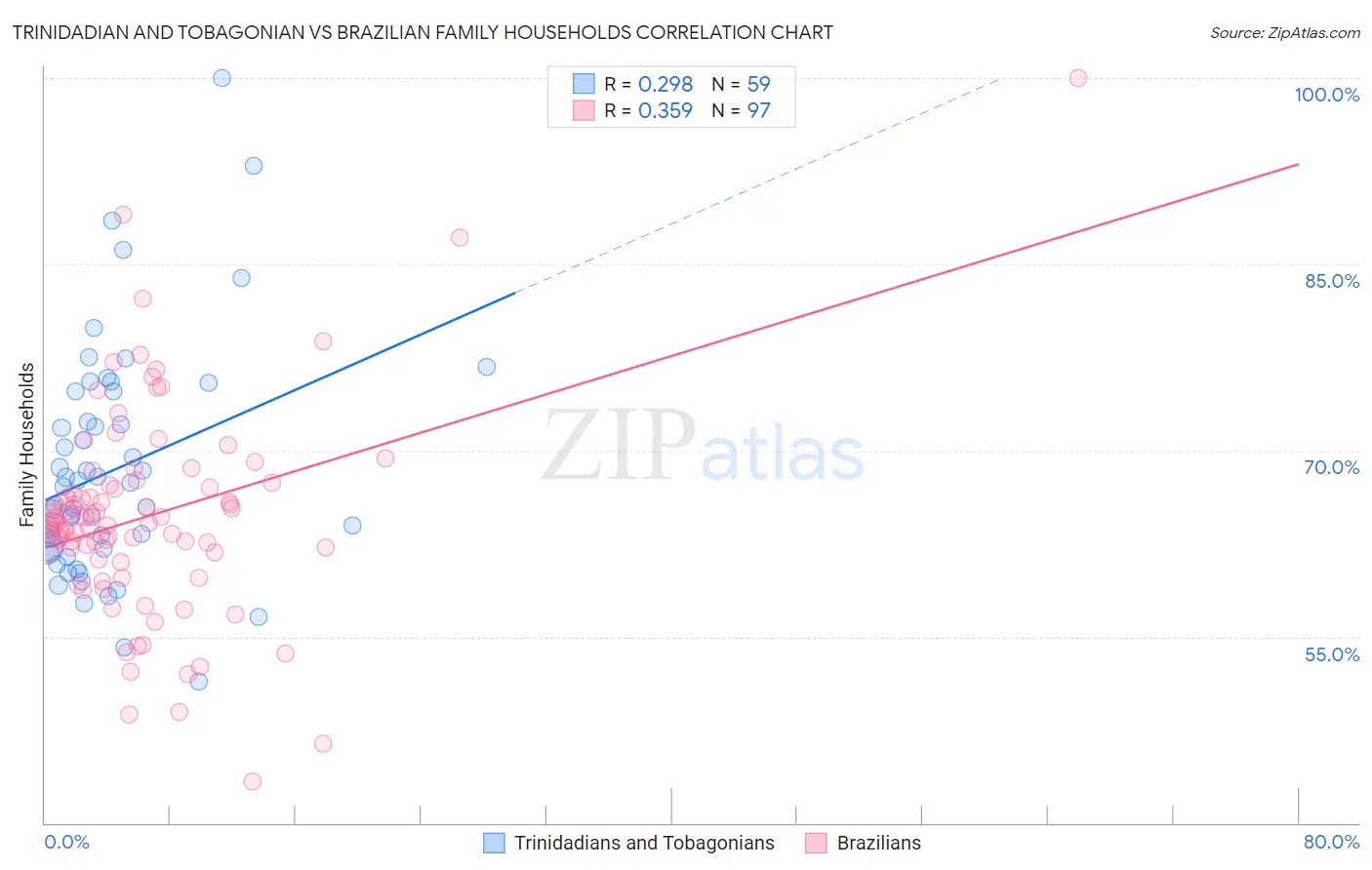Trinidadian and Tobagonian vs Brazilian Family Households
COMPARE
Trinidadian and Tobagonian
Brazilian
Family Households
Family Households Comparison
Trinidadians and Tobagonians
Brazilians
63.6%
FAMILY HOUSEHOLDS
4.1/ 100
METRIC RATING
227th/ 347
METRIC RANK
63.9%
FAMILY HOUSEHOLDS
12.4/ 100
METRIC RATING
205th/ 347
METRIC RANK
Trinidadian and Tobagonian vs Brazilian Family Households Correlation Chart
The statistical analysis conducted on geographies consisting of 219,716,618 people shows a weak positive correlation between the proportion of Trinidadians and Tobagonians and percentage of family households in the United States with a correlation coefficient (R) of 0.298 and weighted average of 63.6%. Similarly, the statistical analysis conducted on geographies consisting of 323,732,843 people shows a mild positive correlation between the proportion of Brazilians and percentage of family households in the United States with a correlation coefficient (R) of 0.359 and weighted average of 63.9%, a difference of 0.40%.

Family Households Correlation Summary
| Measurement | Trinidadian and Tobagonian | Brazilian |
| Minimum | 51.4% | 43.4% |
| Maximum | 100.0% | 100.0% |
| Range | 48.6% | 56.6% |
| Mean | 68.4% | 64.7% |
| Median | 67.1% | 64.2% |
| Interquartile 25% (IQ1) | 62.1% | 61.5% |
| Interquartile 75% (IQ3) | 74.7% | 67.3% |
| Interquartile Range (IQR) | 12.7% | 5.8% |
| Standard Deviation (Sample) | 9.3% | 8.5% |
| Standard Deviation (Population) | 9.2% | 8.4% |
Similar Demographics by Family Households
Demographics Similar to Trinidadians and Tobagonians by Family Households
In terms of family households, the demographic groups most similar to Trinidadians and Tobagonians are Immigrants from Bahamas (63.6%, a difference of 0.010%), Immigrants from Hungary (63.6%, a difference of 0.020%), Turkish (63.6%, a difference of 0.030%), Blackfeet (63.6%, a difference of 0.050%), and Bulgarian (63.6%, a difference of 0.070%).
| Demographics | Rating | Rank | Family Households |
| Immigrants | Europe | 6.4 /100 | #220 | Tragic 63.7% |
| Immigrants | South Africa | 5.9 /100 | #221 | Tragic 63.7% |
| Immigrants | Belarus | 5.5 /100 | #222 | Tragic 63.7% |
| French Canadians | 5.4 /100 | #223 | Tragic 63.7% |
| Turks | 4.5 /100 | #224 | Tragic 63.6% |
| Immigrants | Hungary | 4.3 /100 | #225 | Tragic 63.6% |
| Immigrants | Bahamas | 4.2 /100 | #226 | Tragic 63.6% |
| Trinidadians and Tobagonians | 4.1 /100 | #227 | Tragic 63.6% |
| Blackfeet | 3.6 /100 | #228 | Tragic 63.6% |
| Bulgarians | 3.4 /100 | #229 | Tragic 63.6% |
| Immigrants | Brazil | 3.0 /100 | #230 | Tragic 63.6% |
| Immigrants | Greece | 2.9 /100 | #231 | Tragic 63.5% |
| Immigrants | Northern Africa | 2.6 /100 | #232 | Tragic 63.5% |
| Immigrants | Armenia | 2.6 /100 | #233 | Tragic 63.5% |
| Finns | 2.3 /100 | #234 | Tragic 63.5% |
Demographics Similar to Brazilians by Family Households
In terms of family households, the demographic groups most similar to Brazilians are Immigrants from Uruguay (63.9%, a difference of 0.010%), Immigrants from Lithuania (63.9%, a difference of 0.010%), Iranian (63.9%, a difference of 0.030%), Norwegian (63.9%, a difference of 0.030%), and Nigerian (63.9%, a difference of 0.030%).
| Demographics | Rating | Rank | Family Households |
| Poles | 18.9 /100 | #198 | Poor 64.0% |
| Slavs | 18.6 /100 | #199 | Poor 64.0% |
| Immigrants | Malaysia | 17.9 /100 | #200 | Poor 64.0% |
| Immigrants | Eastern Europe | 17.2 /100 | #201 | Poor 64.0% |
| Iranians | 13.5 /100 | #202 | Poor 63.9% |
| Norwegians | 13.2 /100 | #203 | Poor 63.9% |
| Immigrants | Uruguay | 12.8 /100 | #204 | Poor 63.9% |
| Brazilians | 12.4 /100 | #205 | Poor 63.9% |
| Immigrants | Lithuania | 12.1 /100 | #206 | Poor 63.9% |
| Nigerians | 11.5 /100 | #207 | Poor 63.9% |
| Immigrants | Bangladesh | 11.4 /100 | #208 | Poor 63.9% |
| Sierra Leoneans | 11.2 /100 | #209 | Poor 63.9% |
| Immigrants | Thailand | 9.6 /100 | #210 | Tragic 63.8% |
| Shoshone | 9.4 /100 | #211 | Tragic 63.8% |
| Immigrants | Netherlands | 9.4 /100 | #212 | Tragic 63.8% |